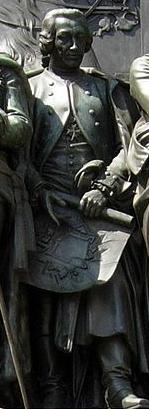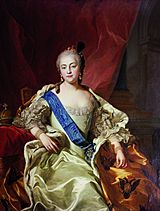Siege of Kolberg (Seven Years' War) facts for kids
During the Seven Years' War, the town of Kolberg (now called Kołobrzeg) was part of Prussia. Russian armies tried to capture Kolberg three times. The first two attempts, in 1758 and 1760, did not succeed. The third and final attempt in 1761 was successful. In the 1760 and 1761 sieges, Swedish soldiers helped the Russian forces.
When Kolberg fell, Prussia lost its last big port on the Baltic Sea. This also meant Russian soldiers could stay in Pomerania for the winter. However, the Russian Empress Elizabeth of Russia died soon after the victory. Her successor, Peter III of Russia, made peace with Prussia and gave Kolberg back.
Contents
First Attack on Kolberg (1758)
Quick facts for kids Siege of Kolberg (1758) |
|||||||
|---|---|---|---|---|---|---|---|
| Part of the Third Silesian War (Seven Years' War) | |||||||
|
|||||||
| Belligerents | |||||||
| Commanders and leaders | |||||||
| General-Major Johann Palmenbach | Heinrich Sigismund von der Heyde | ||||||
| Strength | |||||||
| 5,000 men, 20 guns | 700 | ||||||
| Casualties and losses | |||||||
| Unknown | Unknown | ||||||
The first attack on Kolberg happened in 1758. Prussian defenders successfully stopped the Russian army. Russian Count Fermor was told to remove Prussian forces from Pomerania. He also had to take Kolberg and set up winter camps there. Fermor thought this would be very hard to do.
Fermor sent 4,000 soldiers and 20 cannons to attack Kolberg. This force was led by Lieutenant-General Johann Palmenbach. Kolberg was defended by 700 Prussian soldiers. Their leader was Heinrich Sigismund von der Heyde. He had just made the town's defenses stronger and gathered supplies.
The attack started on October 4. Russian reinforcements arrived, making Palmenbach's army 5,000 strong. But heavy rain and storms made it impossible to build siege structures. Also, 27 Russian warships came to help from the sea. However, storms wrecked 21 of them. None got close enough to join the fight. The siege ended on November 1 after several failed attacks.
Second Attack on Kolberg (1760)
| Siege of Kolberg (1760) | |||||||
|---|---|---|---|---|---|---|---|
| Part of the Third Silesian War (Seven Years' War) | |||||||
|
|||||||
| Belligerents | |||||||
| Commanders and leaders | |||||||
|
Army:
Fleet:
|
|||||||
| Strength | |||||||
|
Army:
Fleet:
|
3,800 (relief force) | ||||||
| Casualties and losses | |||||||
| 600 | 22 killed 47 wounded |
||||||
In 1760, Russian forces wanted to set up their winter camps near the Oder River. To do this, they needed to capture the Kolberg fortress. In July, a Russian army led by Gottlob Heinrich Tottleben moved into Pomerania. But they were then ordered to go to battles in Silesia instead.

On August 27, the entire Russian Baltic fleet attacked Kolberg from the sea. There were 21 ships of the line, three frigates, and three bomb vessels. They arrived the day before. On August 29, six more ships and three frigates from their Swedish allies joined them. About 8,000 soldiers landed and began building siege defenses on September 6. Prussian Colonel Heinrich Sigismund von der Heyde led Kolberg's defense.
The siege was slow. Frederick II of Prussia ordered 3,800 soldiers, led by Major-General Paul von Werner, to leave Silesia. They were to go and help Kolberg, which was about 340 kilometers (210 miles) north. After a 13-day journey, Werner's force reached the Russian lines on September 18. They attacked right away. A successful small battle made the attackers think they were facing a much larger army of up to 20,000. This made them retreat to their ships. The Swedish and Russian ships left on September 20 and 23. The Russians lost 600 soldiers.
After this battle, Frederick promoted both Werner and Heyde to lieutenant-general.
Third and Final Attack on Kolberg (1761)
| Siege of Kolberg (1761) | |||||||
|---|---|---|---|---|---|---|---|
| Part of the Third Silesian War (Seven Years' War) | |||||||
 Fall of Kolberg by Alexander Kotzebue |
|||||||
|
|||||||
| Belligerents | |||||||
| Commanders and leaders | |||||||
|
Army:
Fleet:
|
|||||||
| Strength | |||||||
|
Army:
Fleet:
|
31,000–36,000 in all |
||||||
| Casualties and losses | |||||||
| Unknown | 2,929 men, 146 guns, 28 standards and colours captured | ||||||
Gottlob Heinrich Tottleben, who led Russian campaigns in Pomerania the year before, betrayed Russia. He told Frederick about Russia's plans to attack Kolberg again in 1761. Knowing this, Frederick sent supplies to the fortress. He also called Prince Friedrich Eugen of Württemberg back from the Swedish front.
Württemberg reached Kolberg on July 4. He commanded a stronger defense force of 12,000 soldiers. Russian commander Pyotr Alexandrovich Rumyantsev-Zadunaisky, with a smaller force, camped in nearby Köslin on June 23. He was waiting for more soldiers. Polyansky's naval group blocked the town from the sea. It had 24 ships, 1,300 cannons, and 7,000 marines. A Swedish group of 9 ships and 438 cannons also helped Russia. Württemberg wanted to attack Rumyantsev while Prussia had the advantage. But Frederick canceled this plan, saying it was too risky. After 3,000 more Russian soldiers joined Rumyantsev in mid-August, he began the siege of Kolberg on August 22.
Twenty-three Russian warships helped Rumyantsev. Eight more Swedish warships joined later. The town was constantly bombarded from August 25 to September 25. On September 18, Rumyantsev attacked Württemberg's defenses outside the town. He lost 3,000 soldiers but gained little ground. He then changed his plan. Instead of preparing for direct attacks, he decided to cut off Kolberg's supplies.
On September 30, Kolberg received thousands of Prussian soldiers. These were led by Dubislav Friedrich von Platen. With these new soldiers, nearly 20,000 Prussians defended the fortress. Rumyantsev lost naval support on October 9 when Russian warships sailed home due to bad weather. But he received reinforcements from Alexander Borisovich Buturlin's army that same month. His cavalry, led by Gustav Berg, cut off Prussian communication lines. They also fought against Württemberg's 2,700 horsemen and captured at least four of their units.
As the Prussians ran out of supplies, Platen's force was ordered to Berlin in late October. In November, Württemberg left Kolberg. He broke through the Russian lines to meet up with Platen. Then, he tried to attack Rumyantsev from behind. When Platen and Württemberg did not succeed, Platen left as ordered. Württemberg tried several times to get back into the fortress. On December 12, the Russian forces stopped his last attempt at Spie. This was southwest of Kolberg. They caused 1,000 casualties to his force. Württemberg's remaining 8,000 soldiers then went back to Stettin.
On December 16, Kolberg surrendered to Rumyantsev. This allowed his forces to stay in Pomerania for the winter. Another success for Russia was that Rumyantsev's siege kept Platen's forces busy. Frederick had hoped Platen would help him in Silesia once Kolberg was free. By the time Platen escaped, the problems Frederick faced in Silesia were too big to fix. So Platen was ordered to Berlin to help his ally in Saxony.
The 1761 siege of Kolberg was a big step in how the Russian army fought. Here, Rumyantsev used a new way of fighting. He used troops in battalion (regimental) columns, combined with spread-out groups of jaegers.
What Happened Next (Aftermath)
Around the time of the sieges, Russian Empress Elizabeth of Russia was very sick. She died on December 25, 1761 (Old Style) or January 5, 1762 (New Style). Her nephew, Peter III of Russia, became the new ruler. Peter admired Frederick and had partly grown up in Berlin.
Peter did not like Russia being in the Seven Years' War. He stopped fighting Prussia right away. Under the Treaty of Saint Petersburg, he gave all captured lands (including Kolberg) back to Prussia. He also sent 20,000 soldiers to help Frederick.
Without their Russian ally, the Austrian House of Habsburg did not want to continue the war alone. They made peace with Prussia in the Treaty of Hubertusburg. This treaty returned things to how they were before the war.
See also
- Pomerania during the Early Modern Age
Sources



